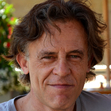Fabrizio Pregadio's Blog, page 2
December 17, 2013
The Principles of Alchemy
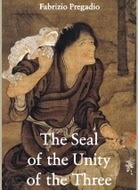 "Know the white, keep to the black," (*)
"Know the white, keep to the black," (*)and the Numinous Light will come of its own.
White is the essence of Metal,
Black the foundation of Water.
Water is the axis of the Dao:
its number is 1.
At the beginning of Yin and Yang,
Mystery holds the Yellow Sprout;
it is the ruler of the five metals,
the River Chariot of the northern direction.
That is why lead is black on the outside
but cherishes the Golden Flower within,
like the man who "wears rough-hewn clothes but
cherishes a piece of jade in his bosom," (**)
and outwardly behaves like a fool.
(*) This sentence is quoted from the Daode jing, sec. 28
(**) This sentence is quoted from the Daode jing, sec. 70
▶ Quoted from The Seal of the Unity of the Three: A Study and Translation of the Cantong qi, the Source of the Taoist Way of the Golden Elixir, by Fabrizio Pregadio, pages 78-79— Read more on and from this book
Subscribe to the free Golden Elixir Quote of the Week — Short quotes on Internal Alchemy (Neidan) from books published by Golden Elixir Press - See samples and the subscription form — See a complete index of the Quotes published until present.

Published on December 17, 2013 04:03
December 13, 2013
The One Opening of the Mysterious Barrier
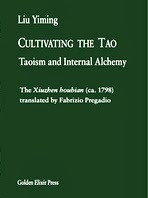 ▶ Quoted from Cultivating the Tao: Taoism and Internal Alchemy, by Liu Yiming, pages 78-79— Read more about this book
▶ Quoted from Cultivating the Tao: Taoism and Internal Alchemy, by Liu Yiming, pages 78-79— Read more about this bookNow I will not hesitate to speak, and I will give a true reflection of the spirit our ancestral masters, bringing forth what they did not bring forth and disclosing what they did not disclose. Joining them by means of my Spirit, being one with them by means of my Intention, I say to my companions:
This Opening has a shape similar to Penglai:
outside it is small, inside it is large,
and its depth cannot be fathomed.
It is not round and it is not square;
within it, "the black and the white tally with each other," (1)
and darkness and light pervade one another.
Its gate is fifty feet high and four feet wide,
and has two panels:
once they open, once they close.
On its left coils a green dragon,
on its right is couched a white tiger,
above flies a vermilion sparrow,
below rests a black turtle.
Vague and indistinct! Dim and obscure! (2)
A True Man lives inside it:
his name is Spirit of the Valley,
his appellation is Living a Long Life.
At daytime, he eats a broth of millet; (3)
at night, he drinks the liquor of the boundless.
Sometimes he sings, clear and peaceful;
sometimes he is motionless, and keeps his mouth closed.
When he exhales, the gate of the Opening is wide open,
when he inhales, the gate of the Opening is firmly shut.
(1) Cantong qi (The Seal of the Unity of the Three), 56:2; trans. Pregadio, The Seal of the Unity of the Three, p. 102.
(2) The expressions "vague and indistinct" and "dim and obscure" derive from the Daode jing (Book of the Way and Its Virtue), sec. 21: "Vague and indistinct! Within there is something. Dim and obscure! Within there is an essence".
(3) This alludes to the Elixir, one of whose appellations is "pearl sized as a grain of millet."
Subscribe to the free Golden Elixir Quote of the Week — Short quotations on Internal Alchemy (Neidan) from books published by Golden Elixir Press - View a sample and the subscription form

Published on December 13, 2013 16:43
November 28, 2013
New Book: "Cultivating the Tao", by Liu Yiming (1734–1821)
Golden Elixir Press is pleased to announce the publication of Cultivating the Tao: Taoism and Internal Alchemy, by Liu Yiming.
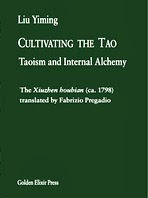 Cultivating the Tao is a complete translation of one of the main works by the renowned Taoist master Liu Yiming (1734-1821). Divided into 26 short chapters, this book provides a comprehensive overview of the basic principles of Taoism and an introduction to Taoist Internal Alchemy, or Neidan, written by one of the greatest representatives of this tradition.
Cultivating the Tao is a complete translation of one of the main works by the renowned Taoist master Liu Yiming (1734-1821). Divided into 26 short chapters, this book provides a comprehensive overview of the basic principles of Taoism and an introduction to Taoist Internal Alchemy, or Neidan, written by one of the greatest representatives of this tradition.Liu Yiming was an 11th-generation master of the Longmen (Dragon Gate) lineage. Having recovered from severe illness in his youth, he undertook extended traveling that led him to meet his two main masters. In 1780, he settled in the Qiyun mountains, in the present-day Gansu province, and devoted the second half of his life to teaching and writing. His works mainly consist of writings on Neidan and of commentaries on major Neidan scriptures.
Liu Yiming grafts Internal Alchemy onto the teachings of the Book of the Way and Its Virtue (Daode jing) and of the later Taoist tradition. Few other masters have illustrated the relation between Taoism and Internal Alchemy as clearly as he does in this book.
• Visit the Web page on this book and read a PDF sample
• See below for a New Publication 20% Discount.
Publication Data:
Liu Yiming
Cultivating the Tao: Taoism and Internal Alchemy
The Xiuzhen houbian (ca. 1798),
translated with Introduction and Notes by Fabrizio Pregadio
Golden Elixir Press, 2013
Paperback, 180 pages
ISBN 978-0-985547516
List price: US$ 17.95 - € 13.95 - GBP 11.95
New Publication 20% Discount:
US$ 14.35, or equivalent in Euros or GBP
Buy from CreateSpace (an Amazon.com company): https://www.createspace.com/4504338
Enter discount code RRPBJYPY at checkout
Offer valid until December 31, 2013

Published on November 28, 2013 12:31
November 19, 2013
Wang Jie on the Precelestial and the Postcelestial Breaths
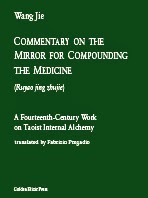
The precelestial Breath is the original and initial Ancestral Breath. This Ancestral Breath is in the real center of Heaven and Earth within the human body. [Placed between] the Secret Door and the Gate of Life, hanging in the middle, it is the Heart of Heaven. The self-cultivation of the divine Immortals only consists in collecting the precelestial One Breath and using it as the Mother of the Elixir.
The postcelestial Breath is the Breath that circulates internally: one exhalation, one inhalation, once coming, once going. "Exhaling touches onto the root of Heaven, inhaling touches onto the root of Earth. On exhaling, 'the dragon howls and the clouds rise'; on inhaling, 'the tiger roars and the wind blows.'"
When [the postcelestial Breath] is "unceasing and continuous," it returns to the Ancestral Breath. The internal and the external inchoately merge, and coalesce to form the Reverted Elixir (huandan).
▶ Quoted from Commentary on the Mirror for Compounding the Medicine: A Fourteenth-Century Work on Taoist Internal Alchemy, by Wang Jie, page 7— Read more on and from this book
Subscribe to the free Golden Elixir Quote of the Week — Short quotes on Internal Alchemy (Neidan) from books published by Golden Elixir Press - View a sample and the subscription form

Published on November 19, 2013 03:54
November 12, 2013
Liu Yiming on "Doing" and "Non-Doing"
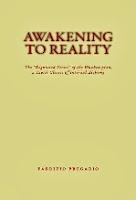
Continue to advance in your practice, passing from "doing" into "non-doing." Nourish [the Embryo] warmly for ten months, keeping it tightly closed [within the womb]. Lessen the excess of strong emotions, and augment the insufficiency of compliant nature. Using the celestial True Fire, and relying on the hexagrams Zhun ䷂ in the morning and Meng ䷃ at night, smelt away the postcelestial Yin breaths. Generate the immaterial from the material, passing from the subtle to the apparent. When Breath is complete and Spirit is whole, "with a peal of thunder the golden cicada sheds its shell," and you have a body outside your body.
When the work is completed and your name is recorded, (*) you will have audience at the Northern Portal and will ride a soaring phoenix. You will fly and rise in the broad daylight, and will become a Celestial Immortal of Pure Yang, free from death. Wouldn’t that be pleasant?
(*) That is, one's name is entered in the "registers of immortality," according to the classical Taoist image for the achievement of transcendence.
▶ Quoted from Awakening to Reality: The "Regulated Verses" of the Wuzhen pian, a Taoist Classic of Internal Alchemy , by Fabrizio Pregadio, pages 87-88— Read more on and from this book
Subscribe to the free Golden Elixir Quote of the Week — Short quotes on Internal Alchemy (Neidan) from books published by Golden Elixir Press - View a sample and the subscription form

Published on November 12, 2013 08:31
September 14, 2013
Autumn 2013 Catalogue & Discount Codes
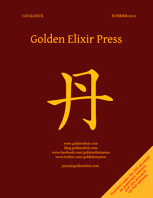
Golden Elixir Press is pleased to announce that the Autumn 2013 catalogue (PDF) is available. Click the picture or the link below to visit the download page.
• Autumn 2013 catalogue
The catalogue includes codes for a 20% discount on paperback editions and a 10% discount on PDF editions. This offer is valid until December 20, 2013.

Published on September 14, 2013 09:20
September 3, 2013
A Graphic Summary of Neidan
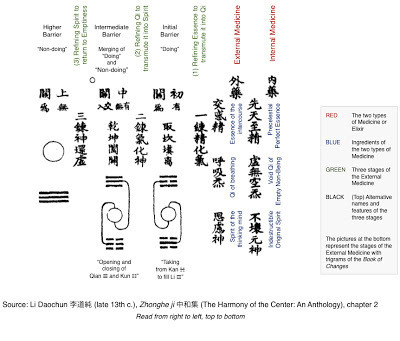
[Click to enlarge the picture]
In his Zhonghe ji (The Harmony of the Center: An Anthology), Li Daochun (late 13th century) makes an important distinction between two Elixirs, which correspond to different degrees of realization. The first Elixir is the Internal Medicine (neiyao), and the second one is the External Medicine (waiyao). Li Daochun says:
The External Medicine allows you to cure illnesses, and to prolong life and have lasting presence. The Internal Medicine allows you to transcend the world, and to exit from Being and enter Non-Being.
The chart reproduced above contains a graphic summary of the two Medicines.
Reading from right to left, the first lines of the chart show the ingredients of the Internal Medicine: Precelestial Perfect Essence, Void Breath (Qi) of Empty Non-Being, and Indestructible Original Spirit. These are the precelestial Essence, Breath, and Spirit, which are already perfected of their own.
The next lines show the ingredients of the External Medicine, which Li Daochun calls Essence of the intercourse, Breath of breathing, and Spirit of the thinking mind. These are the coarse, postcelestial Essence, Breath, and Spirit, which are refined through the Neidan practice.
Then the chart shows the three stages of the Neidan practice, which Li Daochun calls the "three barriers", and which lead from "doing" to "non-doing":
(1) Refining Essence to transmute it into Breath. This stage is characterized by "doing". When it is represented by the trigrams of the Book of Changes, its purpose consists in taking the inner line of Kan ☵ (this line represents True Yang) and returning it to Li ☲, to which it originally belongs.
(2) Refining Breath to transmute it into Spirit. This stage is characterized by the "merging of doing and non-doing". Its purpose is conjoining Qian ☰ and Kun ☷, which represent True Yang and True Yin, respectively.
(3) Refining Spirit to return to Emptiness. This stage is characterized by "non-doing". Its purpose is reverting from Pure Yang to Emptiness. Pure Yang, also represented by Qian ☰, is the state of Unity, before the division of the Great Ultimate (taiji) into Yin and Yang.
Attaining the Internal and the External Medicines, says Li Daochun, depends on one’s individual qualities:
In general, those who study the Dao should begin from the External Medicine; then they will know the Internal Medicine by themselves. Superior persons have already planted the root of virtue, and know it by birth; therefore they do not refine the External Medicine, and directly refine the Internal Medicine.
Therefore, according to Li Daochun, "superior persons" innately possess the Internal Medicine and are immediately able to "transcend the world". Everyone else should begin from the External Medicine, through which they can reach the point in which they “will know the Internal Medicine by themselves,” and attain the same degree of realization as those who innately possess it. This gradual process is the purpose of Neidan.

Published on September 03, 2013 09:22
February 20, 2013
Commentary on the Mirror for Compounding the Elixir
Golden Elixir Press is pleased to announce the publication of
Commentary on the Mirror for Compounding the Elixir:
A Fourteenth-Century Work on Taoist Internal Alchemy
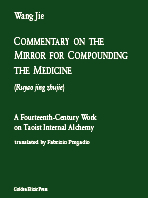
The Ruyao jing (Mirror for Compounding the Medicine) is one of the most famous texts of Taoist Internal Alchemy, or Neidan. Written in the 10th century, it describes the foundations of Internal Alchemy in twenty short poems of four verses. Because of its symbolic and cryptic language, it has been subjected to different and sometimes conflicting interpretations.
This book contains the first complete translation of the Ruyao jing and of the commentary by Wang Jie, who lived in the 14th century. Wang Jie was a second-generation disciple of the great Neidan master, Li Daochun. His commentary is characterized by a strong connection between the doctrinal and the practical aspects of Neidan.
The translator's notes provide details on the main technical terms and on the relation of this work to other important texts of Internal Alchemy, in particular the Cantong qi (Seal of the Unity of the Three) and the Wuzhen pian (Awakening to Reality).
The book is offered with a 15% New Publication Discount until March 15, 2013. See below for this offer.
• Visit the Web page in this book and download a PDF sample (30 pages)
• Amazon link
Publication Data:
Wang Jie
Commentary on the Mirror for Compounding the Medicine:
A Fourteenth-Century Work on Taoist Internal Alchemy
Translated by Fabrizio Pregadio
Golden Elixir Press, 2013
ISBN 978-0-9855475-0-9
104 pp., Paperback
US$ 14.95 • € 10.95 (list price)
New Publication Discount: US$ 12.70, or equivalent in Euros (15% discount)
Buy from CreateSpace: https://www.createspace.com/4150984
Enter discount code H7QDR322 at checkout
This offer is valid until March 15, 2013

Published on February 20, 2013 12:55
January 12, 2013
Golden Elixir Quote of the Week

Golden Elixir Press is starting a new series entitled Golden Elixir Quote of the Week. Each quote consists of a short passage on Neidan (Internal Alchemy) selected from one of the books published by the Press. To view a sample, click the link below.
• Sample Quote of the Week
The Quote of the Week is sent by email to subscribers at no cost. To subscribe, enter your email address in the box below, and click Subscribe.
(If you have troubles seeing or using the subscription form above, use the form available on the Sample Quote of the Week web page. — You can unsubscribe at any time. Golden Elixir Press will never sell or share your email address with anyone.)

Published on January 12, 2013 17:09
October 12, 2012
The Original Stele of the "Neijing tu", a Taoist Chart of the Human Body
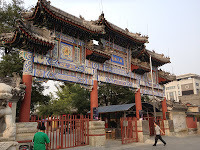
Fig. 1. Entrance to the Baiyun guan
(Click to enlarge this and the other pictures)
The Baiyun guan (Abbey of the White Clouds, fig. 1) in Beijing is one of the most important Taoist monasteries in China. A Taoist temple already existed here in the mid-8th century, but the present site originally dates from around 1200. From the 17th century, the abbey has been the seat of Quanzhen (Complete Reality), the main Taoist lineage in northern China.
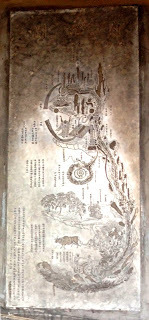
Fig. 2. The Neijing tu stele
While Quanzhen allows for different forms of individual practice — especially meditation — and also includes forms of Taoist communal ritual, its methods incorporate a brand of Neidan (Internal Alchemy) that emphasizes the cultivation of one’s inner nature.
The Neidan view of the human body has often been represented in charts and other illustrations. The Neijing tu, or Chart of the Inner Warp, is the most famous of these charts. It depicts the body as a landscape and shows its main loci according to Neidan, but also draws on the earlier Taoist traditions based on meditation on the inner gods. [See a small or a large reproduction of the Neijing tu].
The Baiyun guan preserves the original stele of the Neijing tu (fig. 2). The stele, dating from 1886, is encased in the outer walls of one of the buildings of the abbey. It measures about 120cm in height and 50cm in width.
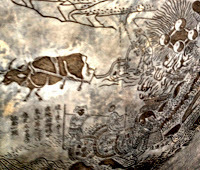
Fig. 3. Lower Cinnabar Field
The chart highlights the three Cinnabar Fields (dantian), which distinguish the Neidan view of the body. Each of them is inhabited by a pair of human figures. At the bottom of the picture (fig. 3) is shown a couple formed by a boy and a girl. Working on a treadmill, they invert the course of the essence (jing) to avoid that it flows downwards and becomes lost. A fiery furnace to their right heats the lower Cinnabar Field, located in the region of the abdomen and here placed near four Yin-Yang symbols. Next to it, on the left, is the "iron buffalo ploughing the earth and planting the golden coin".
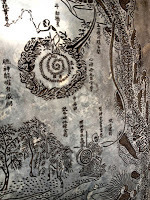
Fig. 4. Middle Cinnabar Field
At the center of the picture (fig. 4) is the middle Cinnabar Field, located in the region of the heart and shaped as a spiral. Above it is the Herd Boy; he holds the constellation of the Northern Dipper, a symbol of the Center of the cosmos. According to a famous Chinese story, the Herd Boy can meet only once a year the Weaving Girl, pictured below him near the kidneys. The Herd Boy and the Weaving Girls are symbols of the alchemical conjunction of Yin and Yang.
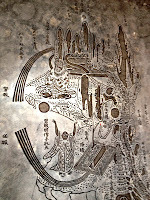
Fig. 5. Upper Cinnabar Field
At the top (fig. 5), the picture shows the upper Cinnabar Field, located among the mountains above the head. To the left of the mountains starts the Control vessel (dumai), which runs along the back of the body. Below the Control Vessel begins the Function Vessel (renmai), which runs along the front of the body. (Both vessels are represented by five parallel lines.) During the first stage of the Neidan practice, the essence is circulated along the circuit formed by the two vessels by means of breathing. Next to the Function Vessel sits an old man, who is Laozi. Next to Control Vessel stands a monk with raised arms, who is Bodhidharma. The two dots represent the Sun and Moon.
The three main sections of the Neijing tu represent the three main stages of the Neidan practice. The Internal Elixir is generated in the lower Cinnabar Field, is nourished in the middle Cinnabar Field, and is achieved in the upper Cinnabar Field.
Pictures taken at the Baiyun guan in Beijing on September 22, 2012.

Published on October 12, 2012 17:15

